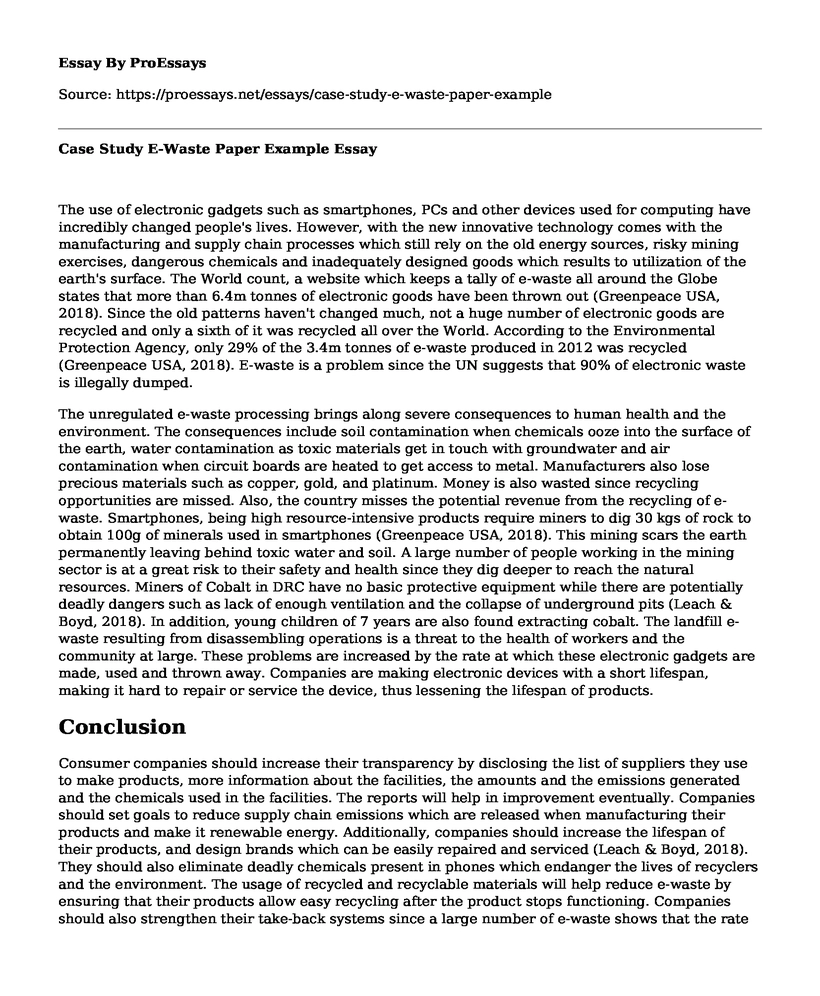The use of electronic gadgets such as smartphones, PCs and other devices used for computing have incredibly changed people's lives. However, with the new innovative technology comes with the manufacturing and supply chain processes which still rely on the old energy sources, risky mining exercises, dangerous chemicals and inadequately designed goods which results to utilization of the earth's surface. The World count, a website which keeps a tally of e-waste all around the Globe states that more than 6.4m tonnes of electronic goods have been thrown out (Greenpeace USA, 2018). Since the old patterns haven't changed much, not a huge number of electronic goods are recycled and only a sixth of it was recycled all over the World. According to the Environmental Protection Agency, only 29% of the 3.4m tonnes of e-waste produced in 2012 was recycled (Greenpeace USA, 2018). E-waste is a problem since the UN suggests that 90% of electronic waste is illegally dumped.
The unregulated e-waste processing brings along severe consequences to human health and the environment. The consequences include soil contamination when chemicals ooze into the surface of the earth, water contamination as toxic materials get in touch with groundwater and air contamination when circuit boards are heated to get access to metal. Manufacturers also lose precious materials such as copper, gold, and platinum. Money is also wasted since recycling opportunities are missed. Also, the country misses the potential revenue from the recycling of e-waste. Smartphones, being high resource-intensive products require miners to dig 30 kgs of rock to obtain 100g of minerals used in smartphones (Greenpeace USA, 2018). This mining scars the earth permanently leaving behind toxic water and soil. A large number of people working in the mining sector is at a great risk to their safety and health since they dig deeper to reach the natural resources. Miners of Cobalt in DRC have no basic protective equipment while there are potentially deadly dangers such as lack of enough ventilation and the collapse of underground pits (Leach & Boyd, 2018). In addition, young children of 7 years are also found extracting cobalt. The landfill e-waste resulting from disassembling operations is a threat to the health of workers and the community at large. These problems are increased by the rate at which these electronic gadgets are made, used and thrown away. Companies are making electronic devices with a short lifespan, making it hard to repair or service the device, thus lessening the lifespan of products.
Conclusion
Consumer companies should increase their transparency by disclosing the list of suppliers they use to make products, more information about the facilities, the amounts and the emissions generated and the chemicals used in the facilities. The reports will help in improvement eventually. Companies should set goals to reduce supply chain emissions which are released when manufacturing their products and make it renewable energy. Additionally, companies should increase the lifespan of their products, and design brands which can be easily repaired and serviced (Leach & Boyd, 2018). They should also eliminate deadly chemicals present in phones which endanger the lives of recyclers and the environment. The usage of recycled and recyclable materials will help reduce e-waste by ensuring that their products allow easy recycling after the product stops functioning. Companies should also strengthen their take-back systems since a large number of e-waste shows that the rate at which electronic devices are produced is much higher than their rate of take-back (Leach & Boyd, 2018). In addition, companies should improve their recycling technology and work with recycling partners to maximize recovery of materials.
References
Guide to Greener Electronics 2017 | Greenpeace USA. (2018). Retrieved fromhttps://www.greenpeace.org/usa/reports/greener-electronics-2017/
Leach, A., & Boyd, O. (2018). Samsung and Greenpeace: what you need to know about e-waste. Retrieved from https://www.theguardian.com/sustainable-business/2017/mar/01/samsung-greenpeace-what-you-need-to-know-e-waste-smartphones-recycling
Cite this page
Case Study E-Waste Paper Example. (2022, Jul 03). Retrieved from https://proessays.net/essays/case-study-e-waste-paper-example
If you are the original author of this essay and no longer wish to have it published on the ProEssays website, please click below to request its removal:
- The Impact of Innovations on Apple's Sales Staff
- Benefits of Renewable Energy on the Environment Essay
- The Mobile Phone Bible Is Now Replacing the Book Bible Paper Example
- Essay Sample on Spiritual Issues Surrounding Disasters
- Research Paper on Global Warming: Are There Positive Effects?
- Global Warming: Rising Temperatures, Floods, and Calamities Ahead - Essay Sample
- The Fisheries Policy - Essay Example







